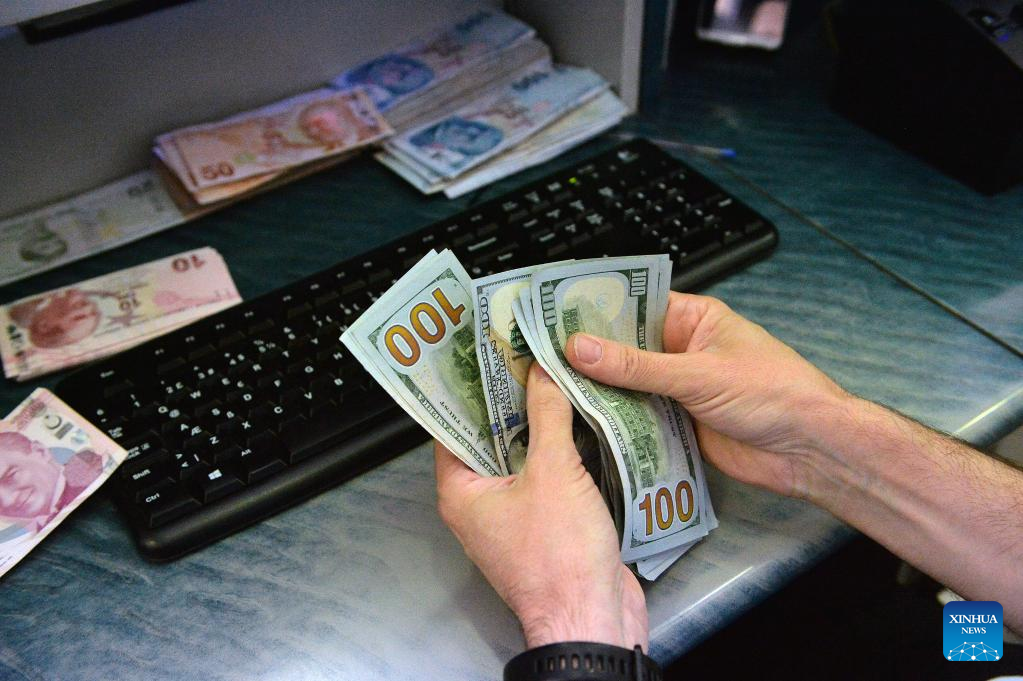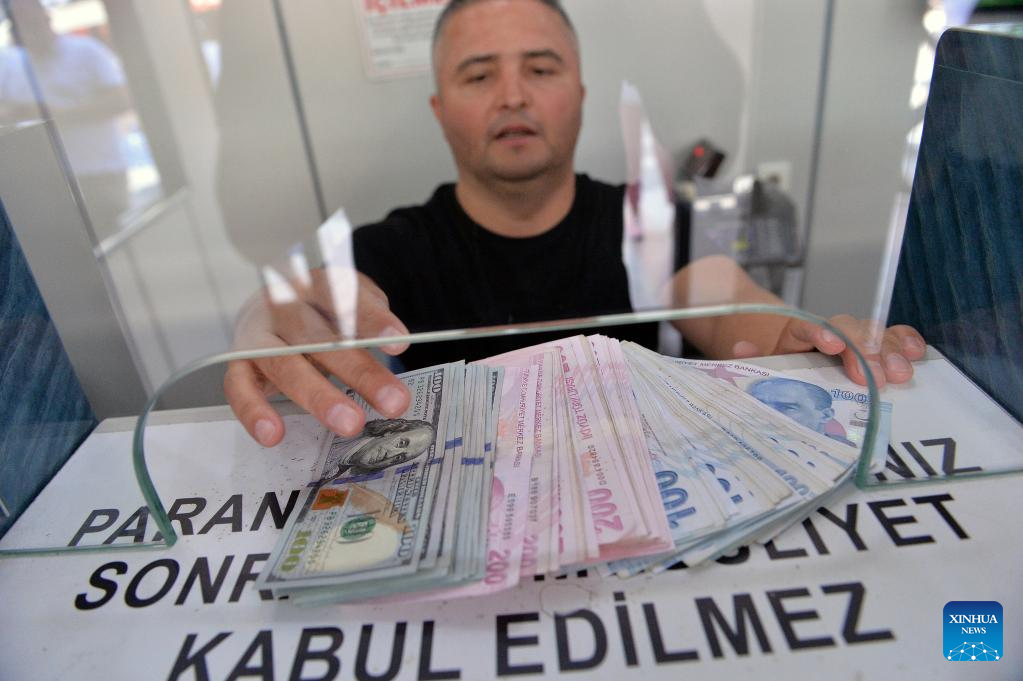
A teller counts banknotes in an exchange office in Ankara, Türkiye, on Aug. 2, 2022. The lira weakened to near 18.0 against the dollar, trading at 17.96 on Tuesday afternoon, a record low since a currency turmoil in December 2021 when it hit an all-time low of 18.4. (Photo by Mustafa Kaya/Xinhua)
by Burak Akinci
ANKARA, Aug. 2 (Xinhua) -- With tumbling currency, low capital inflows and looming short-term external debt, Türkiye's economic woes are far from over, experts said.
The lira weakened to near 18.0 against the dollar, trading at 17.96 on Tuesday afternoon, a record low since a currency turmoil in December 2021 when it hit an all-time low of 18.4.
Meanwhile, there are 182.4 billion dollars of debt in hard currencies that must be paid back or rolled over the next year.
Yet foreign direct investments have largely shrunken in the past three years and the cost of borrowing remains high for forex amid the low foreign currency reserves at the Turkish central bank.
"The lira's recent depreciation against hard currencies, the dollar and the euro will increase naturally the country's premium risks," Enver Erkan, chief economist at Istanbul's Tera Securities, told Xinhua.
"This will inevitably increase the cost of risk (of borrowing) in light of economic instability and unpredictability of the Turkish currency," the expert said.
Erkan explained that in any case, the cost of fresh debt will be around 11 percent as the yields on 10-year U.S. Treasury bonds are nearly 3 percent and Türkiye's perceived risk only continues to increase.
"This is a very high borrowing cost to pay," he added.
Türkiye's current account deficit, the difference between imports and exports for all types of goods and services, has also continued to widen amid the rise in energy prices following the eruption of the Ukraine conflict.
According to the latest figures, the deficit reached 6.5 billion U.S. dollars as of May and may continue to worsen in the fall. An annual deficit of 40 billion dollars is expected for the next year.
There is another factor adversely affecting Türkiye's external balance as well -- the appreciation of the dollar against the euro.
While nearly 60 percent of external debt and some 70 percent of imports are in dollars, Türkiye's revenues from exports and tourism are mainly in euros. As a result, all else being equal, the external deficit is rising once again.
Moreover, inflation is soaring in Türkiye, rising above 78 percent in June.
The central bank cited "supply shocks" resulting from the Russia-Ukraine crisis for the high inflation, specifically with regard to fuel, food and agricultural prices.
And the Turkish government is predicting high inflation for the rest of the year. The central bank last week predicted that the year-end inflation will reach 60.4 percent, up from the previous forecast of 42.8 percent.
Despite the mid-year salary rises for civil servants, pensioners, and minimum wage earners, the purchasing power of households is declining as Türkiye is mired in an inflationary spiral.
Despite high inflation, Türkiye did not raise interest rates as many monetary institutions did to counter inflation.
Some experts said this policy is at the core of Türkiye's woes.
"Turkish interest rates have remained unchanged but at a higher cost. Inflation jumped from 19 percent to nearly 80 percent and the lira depreciated by over 100 percent and markets have been disrupted," said Emre Alkin, finance professor and rector at Istanbul's Topkapi University.
Erkan echoed these remarks, calling for globally established economic policies. But he said there has been "no signal" so far toward this path from the Turkish government.
Meanwhile, Alkin said that consecutive interest rate hikes by the U.S. Federal Reserve to reign in record inflation are bad news and an additional shock for the vulnerable Turkish economy amid the country's surging living costs.
It's widely expected that the effects of the U.S. interest rate hikes will ripple through the world markets, starting with developing countries such as Türkiye. ■

A teller checks a banknote in an exchange office in Ankara, Türkiye, on Aug. 2, 2022. The lira weakened to near 18.0 against the dollar, trading at 17.96 on Tuesday afternoon, a record low since a currency turmoil in December 2021 when it hit an all-time low of 18.4. (Photo by Mustafa Kaya/Xinhua)

A teller shows banknotes in an exchange office in Ankara, Türkiye, on Aug. 2, 2022. The lira weakened to near 18.0 against the dollar, trading at 17.96 on Tuesday afternoon, a record low since a currency turmoil in December 2021 when it hit an all-time low of 18.4. (Photo by Mustafa Kaya/Xinhua)

A customer exchanges money in an exchange office in Ankara, Türkiye, on Aug. 2, 2022. The lira weakened to near 18.0 against the dollar, trading at 17.96 on Tuesday afternoon, a record low since a currency turmoil in December 2021 when it hit an all-time low of 18.4. (Photo by Mustafa Kaya/Xinhua)

A customer exchanges money in an exchange office in Ankara, Türkiye, on Aug. 2, 2022. The lira weakened to near 18.0 against the dollar, trading at 17.96 on Tuesday afternoon, a record low since a currency turmoil in December 2021 when it hit an all-time low of 18.4. (Photo by Mustafa Kaya/Xinhua)
